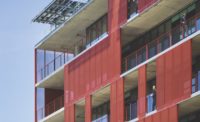The Irish capital revamps its riverfront industrial lands, creating a mixed-use development with architecture by design luminaries such as Libeskind, Roche, and Calatrava.
| Photos courtesy DDA |
The Grand Canal Theatre, by Studio Daniel Libeskind (above). Click on the slide show button to see more images of architecture in the Dublin Docklands. |
The economic boom that began in the mid-1990s and transformed Ireland from one of Europe’s poorest countries into a Celtic Tiger has been all but dead for several years. However, the fruits of the more prosperous times are evident everywhere, including in the Dublin Docklands — about 1,300 acres of former industrial land and economically challenged residential neighborhoods along the north and south banks of the Liffey River, between the city center and Dublin Bay.

Since 1997, the Dublin Docklands Development Authority (DDDA), a self-financing state body, has been overseeing the Docklands’ social and economic regeneration and the physical makeover of its core into a dense and modern mixed-use district. In that time, the area has attracted $6.8 billion in public and private investment, the number of people working there has almost doubled, to 40,000, and the residential population has increased to 22,000 from 17,500, says the DDDA.
Architecture has played a big role in the growth. Among the many buildings completed in the last two years are a community center enclosed in a concrete skin with porthole-like windows, by Dublin’s O’Donnell + Tuomey; a convention center by the Irish-born, Connecticut-based Kevin Roche with a cylindrical glass atrium overlooking the river; and a 2,000-seat theater by Daniel Libeskind featuring his hallmark angular and canted surfaces. The district also has new parks, office and retail space, and residential units (both market-rate and affordable).
Not surprisingly, the DDDA has suffered along with the rest of the Irish economy. In its 2009 annual report (the most recent available), the authority claims a deficit of $25.3 million, a good portion of which can be attributed to a drop in property values. Stalled Docklands projects include the Watchtower — a 330-foot-tall mixed-use building by Dublin’s Scott Tallon Walker with Wilkinson Eyre Architects, London. Also on hold is Foster + Partners’ mostly residential triangular U2 Tower, so-named because it would house the rock band’s studio. A hotel adjacent to the Libeskind theater, by Portuguese architect Manuel Aires Mateus, is almost complete but has no operator. “The whole development is in hibernation,” says Loretta Lambkin, DDDA spokeswoman.
A few other undeveloped sites still exist within the core of the Docklands district. New transportation infrastructure, including a traffic bridge by Santiago Calatrava and an extension of the light-rail system, both completed in late 2009, should make the remaining parcels more attractive for development when the market improves, predicts Lambkin. “Other projects will come on the back of those,” she says.
Despite the downturn, the DDDA still has grand long-term ambitions, including extending the redevelopment farther east to the Poolbeg Peninsula, which juts out from the south bank of the Liffey into the bay. Here, the authority plans to remake 100 acres of industrial land into another mixed-use quarter. The pace of construction will depend on the state of the economy, but officials expect that realization of the scheme will extend over the next two decades.














Post a comment to this article
Report Abusive Comment